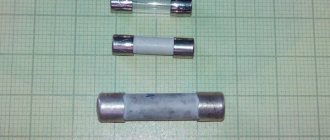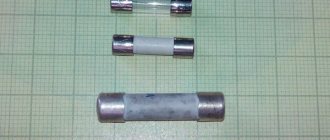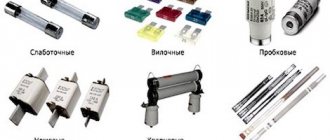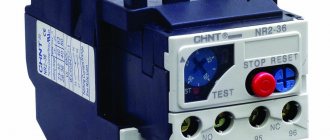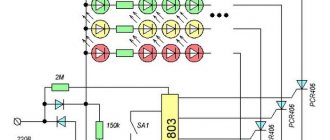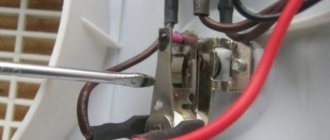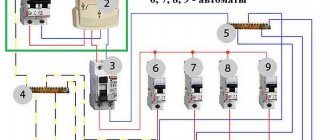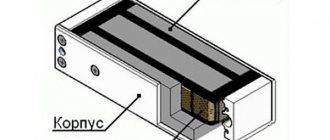Fuse
is an installation product designed to protect electrical appliances by cutting off the supply of electricity to them when the permissible current value is exceeded by melting the calibrated wire installed in the fuse.
To protect electrical wiring and expensive radio equipment from short circuits, current surges in the supply network and ensure the safe operation of electrical appliances, fuses are widely used. They are produced in different designs, standard sizes and for any protection currents.
The considered fuse repair technology, if all conditions are met, will ensure its protective function. But not everyone has experience working with a soldering iron and measuring wire diameter. And in any case, an industrial fuse will work more reliably.
Previously, apartment electrical wiring was also protected exclusively with the help of fuses installed in plugs. Currently, to protect electrical wiring, more reliable reusable short circuit protection devices are used - circuit breakers. In electrical appliances, nothing better protection against short circuits than a fuse has yet been invented. The use of fuses in cars is especially important, since they are the only reliable and cheap means of protection against short circuits.
Conventional graphic designation of a fuse
The conventional graphic designation of a fuse in the diagrams is similar to the designation of resistance, and differs only in that the line passes through the middle of the rectangle without breaking. Next to the symbol, the letter Pr is usually written. or F. Sometimes the diagrams simply write thermal fuse or fuse. After the letter, the protection current of the fuse is often indicated, for example F 1 A, means that the circuit has a fuse for a protection current of 1 ampere.
During operation, fuses fail and have to be replaced with new ones. It is believed that fuses cannot be repaired. But if you approach the repair process competently, then almost any fuse can be successfully repaired and reused. After all, the fuse body remains intact, and only a thin calibrated wire located inside the body burns out. If the burnt wire is replaced with the same one, the fuse will continue to serve.
Plug type fuses
Separately, I would like to dwell on plug-type fuses. You could meet them in old, and not so old, apartments and houses. By design, this is a permanently installed cartridge into which a fuse with a base is screwed. In an emergency, the plug burns out. In a modern design, the plug may have a button, which is analogous to a switch. After an accident, the button resets the safety to the operating position.
Interesting on the topic: How to check a zener diode.
Connecting the plug fuse
There is nothing complicated about connecting a plug fuse with your own hands. The fuse has two terminals. A phase power wire is connected to the input terminal, and the second phase wire supplies power to the apartment or house.
Important! The peculiarity of connecting a plug fuse is the following. If you unscrew the fuse plug, there should be no voltage on the cartridge jacket.
How the fuse works in the video
When an electric current passes less than the maximum permissible, the calibrated wire connecting the fuse contacts heats up to a temperature of about 70˚C. If the current exceeds the fuse rating, the wire begins to heat up more strongly and when the melting temperature of the metal from which it is made is reached, it melts, the electrical circuit breaks, and the flow of current stops.
That's why the fuse is called a fuse or fusible link. The video is presented in slow motion so that you can clearly see how the wire in the fuse burns out. In real conditions, the wire in the fuse burns out almost instantly.
Total views: 217939
The fuse protects against excess current in the circuit and the voltage of the supply network in which it is installed does not matter, it can be a 1.5 V battery, a 12 V or 24 V car battery, a 220 V AC network, a three-phase network 380 V.
That is, you can install the same fuse, for example, with a rating of 1 A, both in the fuse block of a car, and in a flashlight and in a 380 V switchboard. All types of fuses differ only in appearance and design, and work on the same principle - when exceeded of a given current in the circuit, the wire in the fuse melts due to heating.
There are two main reasons for fuse failure, due to surges in the supply voltage or a breakdown inside the radio equipment itself. Rarely, fuse failures also occur due to poor quality.
Many people think that the fuse cannot be repaired. But it is not so. In an emergency situation, when there is no spare at hand and, for example, because a car on the road or an amplifier refuses to work, and the musical accompaniment of a school ball or wedding is disrupted, and all the shops are already closed, there is no choice.
With the right approach, you can successfully restore a blown fuse for temporary use until it is replaced with a new one, preserving its protective functions. Often such problems are solved by simply closing the contacts of the fuse holder with any available wire, or even worse, simply inserting a nail or a piece of thick wire instead of the fuse. Such a decision can completely ruin everything and contribute to a fire.
Fuse arrangement
The basis of the fuse is the so-called fuse link. It is this that burns out when overloaded or short circuited. To extinguish the arc formed when the insert burns out, the insert is surrounded by an arc-extinguishing device. In PN fuses this is a chamber with fine-grained quartz sand. In PR fuses this is a fiber tubular cartridge.
A fuse is a single-pole switching device designed to protect electrical circuits from overcurrents; its action is based on the melting of a metal insert of a small cross-section by current and extinguishing the resulting arc.
Fuse Types
According to their purpose and design, fuses are of the following types:
- Plugs (mainly used to protect electrical wiring and devices in cars);
- With low-current inserts to protect electrical appliances with current consumption up to 6 amperes;
- Cork (installed in panels of residential buildings, designed for protection current up to 63 amperes);
- Knife type (used in industry to protect networks with current consumption up to 1250 amperes);
- Gas generating;
- Quartz.
The repair technology discussed in the article is intended for restoring fork fuses, with low-current inserts, plug and blade type fuses.
Tubular fuses
A fuse of a tubular design is a glass or ceramic tube, closed at the ends with metal caps, which are connected to each other by a wire of calibrated diameter running inside the tube. You can see the appearance of tubular fuses in the photograph.
The wire is spot welded to the caps or soldered with solder. In fuses designed for very high currents, the cavity inside the tube is often filled with quartz sand.
Automotive fuses
Fuses in cars rarely fail. Usually only in cases where the equipment fails. Most often when the headlight bulbs burn out. The fact is that when the filament of a light bulb breaks, a Voltaic arc is formed, the filament burns out and becomes shorter, the resistance sharply decreases and the current increases many times over.
It happens that a fuse in a car burns out when the windshield wipers jam. Less often during short circuits in electrical wiring. In the photo you see widely used automotive blade (fork) type fuses. Below each fuse is the current of its protection in amperes.
A blown fuse in a car should be replaced with a fuse of the same rating, but it can also be repaired by replacing the blown wire in the fuse with a copper wire of the appropriate diameter. The voltage of the car's on-board network does not matter. The main thing is the correspondence of the protection current. If it is difficult to determine the rating of a blown car fuse, then you can use color coding.
Color coding of automotive fuses
| Protection current, Ampere | 5,0 | 7,5 | 10,0 | 15,0 | 20,0 | 25,0 | 30,0 | 40,0 | 60,0 | 70,0 |
| Fuse body color | orange | brown | red | blue | yellow | transparent | green | violet | blue | black |
Description of fuse options and fuses
Types:
- with filling (PN-2, PPN, NPN). An internal cavity filled with materials that extinguish the electric arc that appears during burnout. The circuit is open only when this phenomenon disappears. The extinguishing agent is quartz dust;
- without filling (PR-2). The arc is suppressed by the gas released during activation and heating of the walls of the insert. Low-current PPs may not have this and the previous feature.
Kinds:
- tubular and low current. The first are glass, ceramic or fiber cylinders with clamps at the ends. The second ones are the same, but more often with a glass bulb, for low-power household devices up to 6 A. The insert snaps into a horizontal longitudinal holder with clamp terminals, its metal ends touch the contacts on the cylinder (clamps), thus the product is included in the circuit. Such varieties are usually unfilled, especially if they are fiber: this material, when heated, releases gas to suppress the arc;
- fork Typically for automotive equipment, for units with PCB on control panels. The contacts resemble a plug and are located at the bottom;
- fuse plugs or cork fusible inserts. Standard for 63 A. Serves one-time operation of household consumers. The part that burns out is hidden by ceramics with a cartridge; there is 1 contact on the outside, the other is connected to the plug. The PP burns out, cutting off power to the apartment. Restore power supply by replacing the insert. Such devices were installed in houses of old buildings, but are now used less frequently, since there are AV and RCD. Remain relevant in power plants and industry;
- knife For 100 - 1250 A, used for high values, for example, in the presence of powerful electric motors, in ASU;
- quartz, with quartz dust inside - for values up to 36 kV;
- gas-generating (with or without the possibility of disassembly). When burning (flash), popping noise and intense gas emission occurs (models PSN, PVT). For 35–110 kV. Rating up to 100 A
Formula for calculating the diameter of the fuse wire based on the power of the electrical appliance
Power is often indicated on labels affixed to products. If the power consumption is indicated on the product, then the rated current of the fuse can be calculated using the formula below.
where
I
nom – rated fuse protection current, A;
P
max – maximum load power, W;
U
– supply voltage, V.
But it is much more convenient to use ready-made data from tables. Please note that the first table is used to select the fuse rating of products powered from a 220 V household power supply, and the second table is for products used in cars with an on-board voltage of 12 V.
Table for selecting the fuse rating depending on the power consumption of the electrical appliance at a supply voltage of 220 V
| Maximum power consumption of an electrical appliance, watt (BA) | 10 | 50 | 100 | 150 | 250 | 500 | 800 | 1000 | 1200 | 1600 | 2000 | 2500 | 3000 | 4000 | 6000 | 8000 | 10000 |
| Standard fuse rating, A | 0,1 | 0,25 | 0,5 | 1,0 | 2,0 | 3,0 | 4,0 | 5,0 | 6,0 | 8,0 | 10,0 | 12,0 | 15,0 | 20,0 | 30,0 | 40,0 | 50,0 |
Let's look at an example of how to choose a fuse. The TV stopped working after a thunderstorm. It has been determined that the fuse has blown. Its denomination is not known. On the back cover label it is written that the power consumption is 120 W, sometimes it is written as 120 VA. This is a designation of the same power, but according to the standards of different countries. According to the table, it turns out that for electrical appliances with a maximum power consumption of 120 W (the closest value is 150 W) there is a 1 A fuse.
The method for selecting a fuse to protect the on-board electrical wiring of a car is no different from the choice for 220 V household electrical wiring.
Table for selecting the fuse rating depending on the power consumption of the electrical appliance at a supply voltage of 12 V (vehicle on-board network)
| Electrical appliance power, watt (BA) | up to 50 | up to 75 | up to 100 | up to 150 | up to 200 | up to 250 | up to 300 | up to 400 | up to 600 | up to 700 |
| Standard fuse rating, A | 5,0 | 7,5 | 10,0 | 15,0 | 20,0 | 25,00 | 30,0 | 40,0 | 60,0 | 70,0 |
| Fuse body color | orange | brown | red | blue | yellow | transparent | green | violet | blue | black |
If after two replacements the fuses blow out each time, it means that the electrical appliance is damaged and requires repair. An attempt to install a fuse at a higher current can only cause further damage to the product, up to and including irreparability.
Fuse current calculator
If the tables do not contain data for your case, for example, the supply voltage of the product is 24 V or 110 V, then you can perform the calculation yourself using the online calculator below.
| Online calculator for determining fuse current | |
| Maximum load power, W: | |
| Supply voltage, V: | |
When calculating on a calculator you will get the exact current value. For reliable operation of the fuse, its rating must be at least 5% higher. For example, if a calculated current value of 1 A is obtained, then you need to take a fuse of the highest closest rating from the standard range, that is, 2 A.
Sometimes attempts to determine the fuse rating by reading the information do not work. There are no inscriptions on the electrical device; the markings on the fuse are unreadable. If you have an ammeter and experience working with it, then by removing the fuse and connecting the ammeter to the contacts of the block in which the fuse was installed, you can measure the current and thereby determine its rating.
But there is a pitfall here. If the fuse fails due to a malfunction of an electrical device, then the current may be much greater than it should be, in addition, the measuring device may also be damaged.
Classification of devices
A fuse is a single-pole switching device designed to protect electrical circuits from overcurrents; its action is based on the melting of a metal insert of a small cross-section by current and extinguishing the resulting arc. Valuable properties of fuses are:
- simplicity of the device and, therefore, low cost;
- exceptionally fast circuit disconnection during short circuit;
- the ability of some types of fuses to limit short-circuit current.
- However, it should be pointed out that:
- the characteristics of the fuses are such that they cannot be used to protect circuits under overloads;
- selective shutdown of circuit sections when protected by fuses can be ensured only in radial networks;
- automatic restart of the circuit after it has been turned off by a fuse is only possible when using multiple-action fuses of a more complex design;
- disconnection of circuits by fuses is usually associated with overvoltages;
- single-pole outages and subsequent abnormal operation of sections of the system are possible.
It will be interesting➡ The principle of operation of a self-resetting fuse
Therefore, in electrical installations above 1 kV, fuses have limited use; They are mainly used to protect power transformers, voltage instrument transformers and static capacitors. A fuse consists of the following main parts: an insulating base or a metal base with insulators, a contact system with clamps for connecting conductors, a cartridge with a fuse link. Most fuses have trip indicators of one design or another.
Fuses of various ratings.
Fuses are characterized by rated voltage, rated current and rated breaking current. It is necessary to distinguish between the rated current of the fuse link and the rated current of the fuse (contact system and cartridge). The latter is equal to the rated current of the largest of the inserts intended for it. For AC fuses with a rated voltage from 3 to 220 kV inclusive, the following rated current values are established:
- Rated currents of fuses, A……8; 10; 20; 32; 40; 50; 80; 160; 200; 320; 400
- Rated currents of fuse links, A……2; 3.2; 5; 8; 10; 16; 20; 32; 40; 50; 80; 160; 200; 320; 400
- Rated shutdown currents, kA……2.5; 3.2; 4; 5; 6.3; 8; 10; 12.5; 16; 20; 25; 31.5; 40
The rated breaking current should be understood as the maximum permissible effective value of the periodic component of the short-circuit current, turned off by a fuse under certain conditions. Domestic hardware factories produce fuses for voltages up to 110 kV inclusive. The highest temperature of the fuse parts charged with any of the fuse-links intended for it should not exceed the values indicated in Table 1 at an air temperature of +40°C.
Useful material: what is a semiconductor diode.
Calculation of fuse wire diameter
To repair the fuse, it is necessary to replace the burnt wire. In the production of fuses in factories, depending on the current value and speed, calibrated silver, copper, aluminum, nickel, tin, lead and wires made of other metals are used.
For making a fuse at home, only red copper of calibrated diameter is available. All electrical wires are made of copper, and the more elastic the wire, the thinner the conductors and the greater the number of them. Therefore, all the technology proposed below is focused on the use of copper wire.
When choosing a fuse for equipment, developers use a simple law. The fuse current must be greater than the maximum consumed by the product. For example, if the maximum current consumption of the amplifier is 5 amperes, then the fuse is selected at 10 amperes. The first thing you need to do is find its marking on the fuse body, from which you can find out what current it is designed for. Often the current value is written on the product body, next to the location where the fuse is installed. Then, from the table below, determine what diameter wire is needed.
Power calculation
The fuse link is selected so that it melts before the temperature of the line wires reaches a dangerous level or the overloaded consumer fails. Based on their design features, there are plate, cartridge, tube and plug fuses. The current strength for which the fuse-link is designed is indicated on its body. The maximum permissible voltage at which the fuse can be used is also specified.
It will be interesting➡ The principle of operation of a self-resetting fuse
This curve is measured experimentally: a batch of identical fuses is taken, which are sequentially burned at different currents. The time after which the insert burns out and the current passing through the insert are measured. Each current corresponds to a certain burnout time of the insert. Based on these data, a time characteristic is constructed.
Probably all of us have seen the ceramic “plugs” that are wrapped in the electric meter panel. Until recently, and sometimes even now, they still serve as protection devices. From personal experience - I have repeatedly encountered this connection scheme - there are two plugs in the panel, one is in the phase wire, the second is in the neutral wire. But what kind of switching scheme is categorically incorrect! Under no circumstances should a fuse be connected to the neutral wire. After all, what happens if it fails - the circuit will break down and will be protected, but consumers will still be under the network potential - the phase is present. And these are issues of electrical safety.
Fuse made in the USSR.
Despite the fact that fuses have served their purpose and become obsolete as protection devices in household bushings, throughout their existence they have adequately performed this function. Fuses, of course, cope with their functions of protecting against excess current consumption or short circuit. However, today, especially in the household sector, fuse links are becoming a rarity.
Plus, these are quite dangerous devices in terms of fire. After all, today many consider themselves electricians, and when the “plug” burns out, some “specialists” install “bugs” from uncalibrated wire. And, sometimes, quite exotic. I described a typical example in the previous review. And what all this entails - you don’t need to go far - look at the chronicle of the emergency on any TV channel. Therefore, it is quite natural that fuse-links have been replaced by more reliable devices - circuit breakers.
Tables for selecting wire diameter depending on the fuse protection current
For repairing fuses with protection current from 0.25 to 50 amperes
| Fuse protection current, Ampere | 0.25 | 0.5 | 1.0 | 2.0 | 3.0 | 5.0 | 7.0 | 10.0 | 15.0 | 20.0 | 25.0 | 30.0 | 35.0 | 40.0 | 45.0 | 50.0 | |
| Wire diameter, mm | Copper | 0.02 | 0.03 | 0.05 | 0.09 | 0.11 | 0.16 | 0.20 | 0.25 | 0.33 | 0.40 | 0.46 | 0.52 | 0.58 | 0.63 | 0.68 | 0.73 |
| Aluminum | — | — | 0.07 | 0.10 | 0.14 | 0.19 | 0.25 | 0.30 | 0.40 | 0.48 | 0.56 | 0.64 | 0.70 | 0.77 | 0.83 | 0.89 | |
| Steel | — | — | 0.32 | 0.20 | 0.25 | 0.35 | 0.45 | 0.55 | 0.72 | 0.87 | 1.00 | 1.15 | 1.26 | 1.38 | 1.50 | 1.60 | |
| Tin | — | — | 0.18 | 0.28 | 0.38 | 0.53 | 0.66 | 0.85 | 1.02 | 1.33 | 1.56 | 1.77 | 1.95 | 2.14 | 2.30 | 2.45 | |
For repairing fuses with protection currents from 60 to 300 Amps
| Fuse protection current, Ampere | 60 | 70 | 80 | 90 | 100 | 120 | 160 | 180 | 200 | 225 | 250 | 275 | 300 | |
| Wire diameter, mm | Copper | 0.83 | 0.91 | 1.00 | 1.08 | 1.16 | 1.31 | 1.59 | 1.72 | 1.84 | 1.99 | 2.14 | 2.28 | 2.41 |
| Aluminum | 1.00 | 1.10 | 1.22 | 1.32 | 1.42 | 1.60 | 1.94 | 2.10 | 2.25 | 2.45 | 2.60 | 2.80 | 2.95 | |
| Steel | 1.80 | 2.00 | 2.20 | 2.38 | 2.55 | 2.85 | 3.20 | 3.70 | 4.05 | 4.40 | 4.70 | 5.0 | 5.30 | |
| Tin | 2.80 | 3.10 | 3.40 | 3.65 | 3.90 | 4.45 | 4.90 | 5.80 | 6.20 | 6.75 | 7.25 | 7.70 | 8.20 | |
Fuse links. How to choose and calculate current. Operation and Application
Fuse links are electrical elements for protecting equipment from short circuits and overvoltage by turning off power when current load limits are exceeded. Opening the circuit occurs due to the melting of a safety wire of a certain thickness. Several types of these devices are known to the industry. They all differ in internal and external design features, but function according to the same principle.
Nowadays, in order to protect household electrical equipment, more practical reusable circuit breakers are used, but disposable fusible links are still found in plugs. They are especially relevant for premises of temporary and old buildings, where the installation of effective modern shields is not economically justified. In household appliances, there is still no alternative to the classic fuse.
Fuse links are also actively used in industry. The performance of an entire plant or utility network may depend on them. It is better not to buy industrial fuses secondhand, on the market or from unverified organizations. A wise decision is to turn to electronics professionals, for example, the online store Conrad.ru. In such matters, the miser pays not twice, but three times
Formula for calculating the diameter of copper wire for a fuse
To determine more accurate values for the diameter of a copper wire to repair a fuse, or if a fuse is required for a protection current whose value is not in the table, you can use the formula below.
where
I
pr – fuse protection current, A;
d
– diameter of copper wire, mm.
| Online calculator for calculating wire diameter depending on current | |
| Enter the maximum current value, A: | |
Replacing the fuse
When replacing a fuse, to avoid electric shock, be sure to unplug the electrical appliance!
There is an unspoken rule: if after the second replacement the fuse blows again, look for a fault in the electrical appliance itself. This means that the electrical appliance needs to be repaired.
Do not install a fuse at a higher current under any circumstances; such attempts will definitely lead to even greater damage to the device, up to the point of its being beyond repair!
Be careful when purchasing a new fuse. Correctly determine the type and current rating of the replacement candidate. It is better to purchase electronic components from trusted suppliers who guarantee product quality, such as Conrad Electronic.
How to measure wire diameter
The diameter of a thin wire is best measured with a micrometer. If you don’t have a micrometer at hand to measure the diameter of the wire, you can use an ordinary ruler.
You need to wind 10-20 turns per turn of wire on a ruler, divide the number of closed millimeters by the number of wound turns. Get the diameter. For example, I wound 10 turns of wire and they covered 6.5 mm. Divide 6.5 by 10. The diameter of the wire is equal to 0.65 mm. 0.05 mm is occupied by insulation. Therefore, the actual diameter is 0.6 mm.
Such a wire is suitable for making a 30 A fuse. The wire was wound thick for greater clarity. The more turns you wind on the ruler, the more accurate the measurement result will be. You need to wind at least one centimeter. If you have a short length of wire, then wind it around any rod, for example, a screwdriver, toothpick or pencil, and measure the width of the winding with a ruler.
| Online calculator for calculating wire diameter | |
| Winding width on the ruler, mm: | |
| Number of turns: | |
You can process the measurement results using an online calculator. To determine the diameter of the wire, just enter the winding width, the number of turns in the windows and click “Calculate wire diameter”.
Fuse repair
Typical people believe that fuses cannot be repaired; in fact, this is not the case. Most types of fuses can be repaired and given a second, third, etc. life. The fuse housing, as a rule, is destroyed extremely rarely, the wire inside burns out, and the repair consists of replacing it. The main task is to use a wire similar to the one in the fuse.
If you need to replace a fuse very quickly, but you don’t have a spare at hand, you can use the following method:
Remove the paint coating from a wire of a suitable diameter (clean it until it shines) and wind several turns around each fuse contact, then insert the fuse into the holder. This method is popularly called “bug”. With its help you can very quickly check the serviceability of the device, but it is not reliable and can be used as a temporary solution to the problem.
The next method is the so-called “factory” one. Repairs will require a soldering iron, and perhaps a Dremel or screwdriver, but the fuse after repair will look like it came straight from the factory.
Heat the ends of the cup contacts with a soldering iron and remove the solder from the holes in the ends using a toothpick or something similar. It happens that the holes are too small or completely absent, then you will have to drill them. Use a drill of small diameter 1 - 2 mm.
Pass a wire of a suitable diameter through the holes and solder it to the cup contacts.
The fuse is ready!
DIY fuse repair
Tube fuse repair
The first one is the simplest. The wire is stripped to a shine and wound several turns onto each cup, then the fuse is inserted into the holder. This method is unreliable and can only be used as a temporary measure. Due to its simplicity, it allows you to quickly check the serviceability of an electrical appliance. If the wire melts when turned on, then the problem is not the fuse, and more qualified repairs are required.
The second method is somewhat more complicated. But it also does not require soldering. You need to warm up the cups one by one with a lighter or on a gas stove and, holding them through the cloth with your hands, remove them from the glass tube. You can also heat it with a soldering iron. To ensure good contact, the inside of the cup must be thoroughly cleaned of any glue residue.
Pass the wire stripped of insulation through the tube diagonally, bend its ends along the tube and put the cups in place. The fuse has been repaired.
The third method is essentially the same as the first two. But a repaired fuse is practically no different from a new one. The repair is carried out as follows.
When making a fuse, factory calibrated wire is threaded through the holes in the ends of the cups and fixed with solder. In order to insert a new wire, you need to heat the ends of the cups with a soldering iron and use a toothpick or a sharpened wooden stick to free the holes in the ends of the cups from solder. Next, perform the factory operation described above.
There are holes in cups of very small diameter and it is difficult to clean them from solder. Then, if technically possible, it is easier to drill holes with a drill with a diameter of 1-2 mm or widen them with a faceted awl
The proposed technology for repairing fuses and fuse links can be successfully used to restore almost any type of fuses.
Blade type car fuse repair
The technology for repairing a car fuse is no different from the technology for repairing a tubular fuse; it is even simpler, since there is no need to disassemble it.
First, you need to use sandpaper or a file to clean the fuse knives at its base with a strip of a few millimeters and tin these places with solder.
When tinning, I encountered the fact that when using alcohol-rosin flux, the solder did not want to spread over the surface of the knives. I had to use FIM flux, intended for soldering copper, silver, constantan, platinum and ferrous metals. The basis of the flux is phosphoric acid. I always use it for soldering if rosin is not suitable. Residues of FIM flux are removed by washing with water.
The fuse was designed for a protection current of 10 A, therefore, in accordance with the table above, a wire ⌀0.25 mm was taken for repair. The wire was shaped into a loop, as shown in the photo, and its ends were tinned with solder.
After all the preparatory work, all that remains is to insert the wire loop inside the fuse housing and solder the ends to the legs.
Spread solder can be cut off with a knife, removed with sandpaper, or filed off with a file.
The car fuse has been repaired and can now be reused to protect circuits in the car's electrical wiring. If, after installing the repaired fuse, it blows again, then you need to look for a fault in the vehicle’s electrical equipment.
Quartz fuses
Quartz fuses are manufactured for voltages of 6, 10 and 35 kV for indoor and outdoor installation. They belong to the group of current-limiting fuses. The PKT type fuse holder for voltages 3-35 kV (Fig. 4) is a porcelain or glass tube 1, tightly closed with metal caps 2. Inside the tube there is a fuse-link 3 in the form of one or more thin copper wires connected in parallel. The lower cap contains an indicator that fuse 4 has tripped. The cartridge is filled with fine quartz sand.
It will be interesting➡ The principle of operation of a self-resetting fuse
The length of the wires and therefore the length of the chuck is determined by the rated voltage. Since the gradient of the recovering electrical strength of the gap in quartz sand is relatively small, the length of the wire must be long. To place it in the chuck, you have to wind the wire helically.
The characteristics of refractory copper inserts (melting point 1080°C) can be improved by soldering drops of tin or lead, the melting point of which is much lower (200 and 327°C, respectively). When the soldering metal melts, it dissolves copper in itself, as a result of which the insert quickly collapses at a temperature significantly lower than the melting point of the main material of the insert.
The properties of the material filling the current-limiting fuse holder significantly affects the operation of the latter. The filler must meet the following requirements:
- remove heat from the fuse link in normal operating mode;
- do not release gas under the influence of high arc temperature;
- have sufficient electrical strength after a circuit break.
Experience has shown that quartz sand best meets these requirements. The process of disconnecting the circuit with a current-limiting fuse during a short circuit proceeds as follows. At high current, a thin wire melts and evaporates within fractions of a half-cycle almost simultaneously along its entire length. The arc is lit. Due to the high gas temperature, local pressure is formed in the arc channel (the pressure in the chuck practically does not increase). Ionized metal particles are ejected radially into the gaps between the quartz sand grains. Here they are quickly cooled and deionized.
As can be seen from the oscillogram, the voltage at the fuse terminals exceeds the mains voltage due to the appearance of a self-induction EMF directed in accordance with the mains voltage. Switching overvoltages that occur when the circuit is disconnected by fuses must not exceed the following values:
Rated voltage, kV……3..6..10..20..35
Maximum permissible overvoltage in relation to ground, kV……16..26..40..82..126
Glass and ceramic fuses
To limit overvoltage, various measures are taken: inserts with a stepped cross-section along the length are used, which delays the process of their melting and lengthening of the arc; parallel to the main working inserts, auxiliary inserts with a spark gap are included. In the latter case, when the working inserts melt and the voltage sharply increases, the spark gap of the auxiliary insert breaks through, which also burns out. The maximum voltage decreases.
Types of fuses
Devices are classified according to the criterion of electrical circuit breakage. The following types are distinguished:
- Fusible.
The rupture occurs by melting a special insert. - Electromechanical.
A bimetallic element that, when deformed, disconnects contacts. - Electronic.
An electronic circuit controls the key responsible for breaking the circuit. - Self-healing.
Special materials are used for their production. While current flows through the circuit, their properties change, but resume after the current disappears or decreases. Resistance increases, then decreases again.
Fuses are considered the most popular and in demand.
.
What fuses to buy
Some manufacturers are outright slapdash and produce fuses that do not correspond to the declared rating. This leads to the fact that there is ultimately no protection. In the event of an emergency, the fuse does not blow or does not blow in a timely manner. The result is a burnt-out device, a spoiled mood and forced financial losses for the car owner.
It is better to trust recognized market leaders who guarantee the quality of their products. It is with such suppliers that the IXORA store cooperates. You can view the list of available products by following the link to the Catalog. Qualified managers will definitely help you make the right choice and advise on any issues related to car fuses.
| Brand | Number | Name |
| Airline | AFUSL05 | “Standard” fuses with indicator in a blister 10 pcs. |
| Airline | AFUS03 | Automotive fuse set Standard |
| Airline | AFUSP180 | Set of car fuses Standard in a plastic box 180 pieces |
| Airline | AFUV01 | Set of automotive cylindrical fuses |
| Koito | PF2073 | Plastic fuse Koito 20 Amp mini (Blister) |
How to determine the fuse rating from the case and on the board
Before you change something that has gone bad, you need to understand what has gone bad. In our case it burned out. Here you can rely only on the inscription on the board itself or on the fuse, because other methods of finding out what the fuse rating was are very unsteady and groundless. After all, a serviceable fuse will not show anything as zero resistance, but a faulty break. At the same time, do not send it to the laboratory for analysis in order to find out what kind of material it was. Let's look at examples of designation of fuses on the board and SMD elements. By the way, sometimes even a resistor can be used instead of a fuse.
